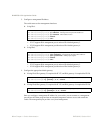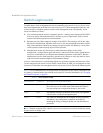
BLADEOS 6.5.2 Application Guide
36 Chapter 1: Switch Administration BMD00220, October 2010
BOOTP/DHCP Client IP Address Services
For remote switch administration, the client terminal device must have a valid IP address on the
same network as a switch interface. The IP address on the client device may be configured
manually, or obtained automatically using IPv6 stateless address configuration, or an IPv4 address
may obtained automatically via BOOTP or DHCP relay as discussed below.
The G8124 can function as a relay agent for Bootstrap Protocol (BOOTP) or DHCP. This allows
clients to be assigned an IPv4 address for a finite lease period, reassigning freed addresses later to
other clients.
Acting as a relay agent, the switch can forward a client’s IPv4 address request to up to four
BOOTP/DHCP servers. In addition to the four global BOOTP/DHCP servers, up to four
domain-specific BOOTP/DHCP servers can be configured for each of up to 10 VLANs.
When a switch receives a BOOTP/DHCP request from a client seeking an IPv4 address, the switch
acts as a proxy for the client. The request is forwarded as a UDP Unicast MAC layer message to the
BOOTP/DHCP servers configured for the client’s VLAN, or to the global BOOTP/DHCP servers if
no domain-specific BOOTP/DHCP servers are configured for the client’s VLAN. The servers
respond to the switch with a Unicast reply that contains the IPv4 default gateway and the IPv4
address for the client. The switch then forwards this reply back to the client.
DHCP is described in RFC 2131, and the DHCP relay agent supported on the G8124 is described in
RFC 1542. DHCP uses UDP as its transport protocol. The client sends messages to the server on
port 67 and the server sends messages to the client on port 68.
BOOTP and DHCP relay are collectively configured using the BOOTP commands and menus on
the G8124.


















